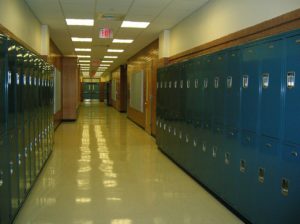I wasn’t required to be there. At my building, high school teachers aren’t expected to be present for crowd control, so they aren’t. And when I walked downstairs to the lobby and auditorium for sophomore (our high school is 10-12) orientation, so as a new teacher, I would know what I was supposed to enforce, I wasn’t expecting to do anything besides greet a few former students. There are no before or after school duties, no locker supervisions during passing times. I don’t even have to sign passes when students use the restroom. Imagine. All of these little freedoms seem as novel to me, a ten year veteran in the junior high, as they do to my sophomores.
This must be because most of the students I see are walking in an orderly fashion, slowly. They are speaking in a reasonable volume, for the most part. They are not excited or excitable, for better, for worse. I did an escape room style activity for the second day of sophomore English, and my fourth hour was just not that worried about the clock. This made me worried about their learning this semester. But that’s a story for another day.
As I walked toward the auditorium, I saw Leslie, a student I had last year. Leslie has some social anxiety and few friends. She struggles in new situations and creates drama around herself as a coping mechanism. Leslie stood near the doorway, alone. I walked over to say hello. After I greeted her, she said softly, “I don’t know what to do.” I realized she was paralyzed: not standing and waiting for someone or trying to look cool, but literally stuck. The nametag table beckoned four feet away, but she had allowed herself to freeze and wait for help she in no way indicated that she needed. I walked with her to the table, told her what to do next, and she made her way into the auditorium. She stood alone in the corner, but at least she was there.
This experience reminds me that presence matters. Junior high teachers are constantly present because if they weren’t, the entire learning environment would suffer. Toilets would clog, hallways would blare at 120 decibels, and there would likely be paper and random Cheetos strewn throughout the building. Many junior high students need reminders that someone is constantly watching them.
But apparently high school students–at least those in transition–still need reminders that someone is just there, for no specific reason at all. And I know all of the awesome high school teachers at my building understand that relationships matter. But I wonder how many relationships are built in hallway interactions and tiny redirections… how many are built on small reminders and reassurances that actually, you do know what to do once you enter a new building on the first day: you find the table with the people behind it.
To be honest, I couldn’t be more excited to NOT be required to do the tiny redirections. I remember saying that part of my job included teaching my eighth and ninth graders how to be human beings: you don’t tell someone they look “tired,” you say please and thank you–to excess, you force yourself to walk when you’re around large groups of people (for example, passing time). It’s nice to focus on content. But there are two things I want to remember. I want to remember that these kids only know to walk and use their manners and be calm because their junior high teachers spent the time and energy on the little things, and now it it is paying off for me. And I want to remember that students still need me to be present in the hallway and in times of transition, in case they need a physical reminder that someone cares. After all, we never get too old to need that.
After ten years of teaching junior high, Brenna Griffin teaches high school English in Cedar Falls, Iowa. You can contact her at [email protected] or @griffin_brenna.








Donna Niday • Oct 30, 2016 at 9:47 pm
Brenna, I thoroughly enjoyed your writing. When I switched from middle school to high school teaching, I was totally amazed that I didn’t have to walk the students from my classroom to the lunch room. Like you, I was excited at my new freedoms! I agree with you, though, that students still need our personal connections. As I observe student teachers, I’ve noticed that several schools now have the policy that every teacher PK-12 should stand at the classroom door and greet each student with a handshake, fist bump, high five, or whatever greeting the student wishes. I think this is a great way to welcome each student into the classroom.